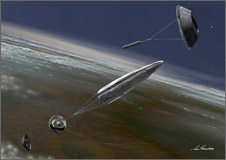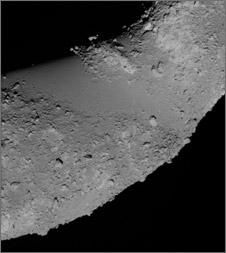

The Hayabusa spacecraft is equipped with an observation instrument, the Near-Infrared Spectrometer (NIRS). The instrument analyzes sunlight reflected off the surface of the asteroid Itokawa by breaking it down into many different colors, or wavelengths. By comparing the data to that acquired from rocks and meteorites on Earth, we can study the make-up and distribution of minerals on the asteroid’s surface. Hayabusa’s onboard camera images a certain range of areas on Itokawa, but NIRS focuses on a single spot for detailed analysis. Hayabusa's NIRS has taken about 75,000 measurements on Itokawa's surface.
Q. What were the results of NIRS observations of Itokawa?

Near-Infrared Spectrometer (NIRS)

Itokawa's surface has bright and dark areas
We already knew, from Hayabusa’s camera, that differences in color and brightness exist on the surface of Itokawa, and we studied these areas in detail with NIRS. First of all, we found out that, compared to the dark areas, the bright areas are less affected by space weathering (the changes caused by solar winds and collisions with micrometeorites, for example), and they are relatively fresh surfaces with little exposure to space. Also, meteorites are classified into different groups according to their characteristics, and we learned that the asteroid Itokawa is similar to ordinary chondrites, the most common type of meteorites to fall to Earth. Furthermore, it became clear that the substances on Itokawa’s surface are monotonous, or, in scientific terms, undifferentiated.
Ordinary chondrites are the most common meteorites to land on Earth. Itokawa is classified as an S-type asteroid, which is also among the most common types. According to ground-based observations, there are differences in the reflectance spectra of ordinary chondrites and S-type asteroids, and it had been a big mystery why these differences exist. But, Hayabusa’s observations have revealed that the spectroscopic data of the S-type asteroid Itokawa and those of ordinary chondrites are very similar. Especially since the data acquired from bright areas on Itokawa are more similar to meteorites, the materials of new surfaces, which have not been influenced by space weathering, are now thought to be possible on meteorites. This indicates that S-type asteroids, including Itokawa, initially had the same spectra as ordinary chondrites, but have been changed over time by exposure to space.
Q. What do you remember most vividly among Hayabusa operations thus far?

An image of Itokawa, taken after Hayabusa's arrival there on September 12, 2005, from about 20 km away.
Among many events, for me it was the initial acquisition of Itokawa’s spectroscopic data. While Hayabusa’s camera can capture images before arrival at the asteroid, the spectrometer needs to get quite close to obtain data because its vision is narrower than the camera’s. Hayabusa arrived at Itokawa on September 12, 2005, but the initial spectroscopic observation was successfully completed two days earlier. We weren’t sure whether data had been captured properly, so after it we received the transmission, I was very moved to see the spectroscopic data from the asteroid for the first time. It had taken 10 years from development to data acquisition. With all our work finally rewarded, I was full of emotion thinking that a lot of data would be collected from that point, and I would be able to analyze it.

Asteroid explorer Hayabusa (a real image of the asteroid Itokawa, and a CG montage of Hayabusa)
Q. What have you learned through the Hayabusa mission?
Our spectrometer team often had discussions about the direction of our research and so on. A theory cannot be established unless you explain your ideas to others and they understand you. You cannot be complacent. I came to realize that the science we are doing is about creating new things and things that are right for humanity through continuous debate. People who shared a passion for asteroid exploration teamed up for the Hayabusa mission. And I also learned that hardship and failures can be overcome by everyone's strong drive and passion.
Q. What does Hayabusa mean to you?
It might sound like a cliché, but Hayabusa is part of my life. I’d like to participate in other missions later, and then Hayabusa will eventually be part of my past. But it's currently an ongoing mission, so I can even say that it is part of my daily life.
Q. What do you think about Hayabusa's return journey?

Hayabusa's Earth return capsule descending to the Woomera Desert in Australia (artist's rendition by A. Ikeshita and JAXA/ISAS)

Asteroid Itokawa
As far as the spectrometer itself is concerned, it acquired data of Itokawa and its objective has been achieved. But Hayabusa's mission is not only to observe the asteroid but also to collect and return asteroid samples to Earth. There is still a long way to go. I was involved in the journey from Earth to Itokawa, as well as the observation operations during Hayabusa's stay at the asteroid. This time, again, I'd like to work with my colleagues on the operation team to make Hayabusa's long return journey successful.
Q. What is your dream for the future?
My goal for the near future is to work on the next asteroid sample return after Hayabusa. Eventually, I'd like to explore someplace where nobody has gone yet, like a celestial body at the end of the solar system. I'm also interested in human exploration spacecraft. It is interesting from a scientific perspective to go and see an untouched place, and it is fantastic from a human perspective, too. I hope that our strong impressions and excitement from these projects will be conveyed to the general public, generating more interest in space and support for further space exploration.
Q. Do you have a message for children who wish to be part of future space development?
My parents tell me that I was very curious as a child. I'm still the same way. I study what I want to know, and try what I'm interested in. Curiosity helps you grow and evolve. So, if there is something you're interested in, go for it. I recommend you look it up or check it out.
Doctor of Science. Research Associate at the Department of Planetary Science, the Institute of Space and Astronautical Science (ISAS)/JAXA.
In 1994, Dr. Abe quit the Department of Earth Science, Graduate School of Science at the University of Tokyo to become an assistant professor at ISAS, and has been in the position since. Dr. Abe also belongs to the Research Office of the JAXA Lunar and Planetary Exploration Group, and is an assistant professor of the School of Science of the University of Tokyo. Dr. Abe specializes in planetary science.







